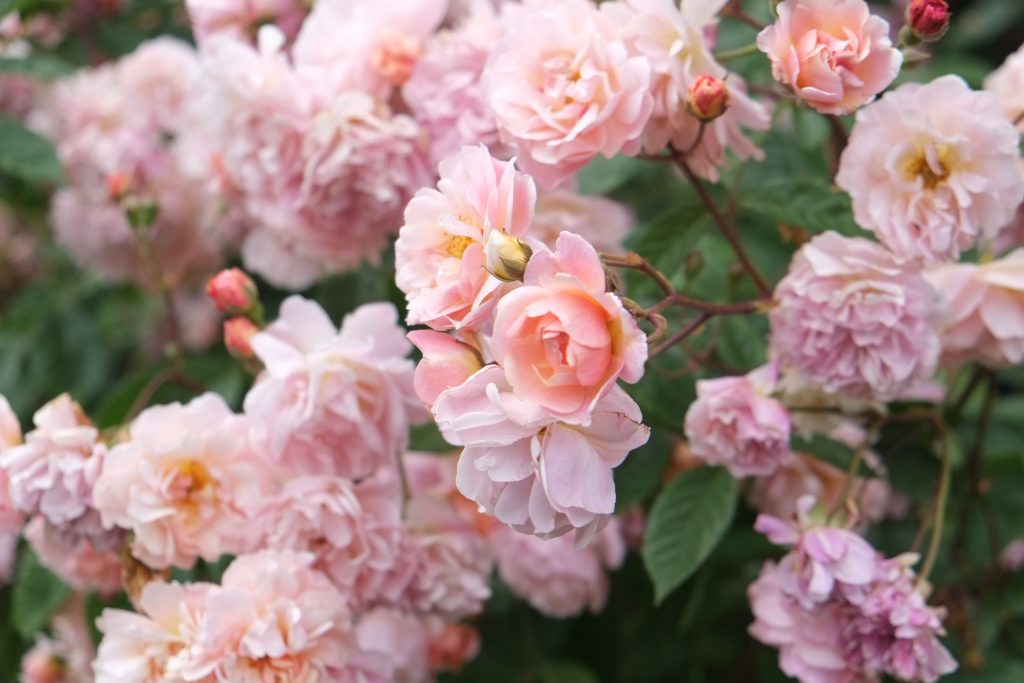
Preserving Workshops: Sugar and Roses
In the second instalment of our winter blog mini-series, Anna details our experiments at Ordsall Hall with sugar and roses, both sleepy ingredients.
Sugar was important at this time of year – in autumn and winter – as it allowed other sleepy ingredients to be preserved after the late summer and early autumn harvest. This was particularly important in the cold dark winter months when sleep problems could still occur during the long nights. Sugar was a good way to administer medicinal ingredients and was itself believed to warm the stomach during a season thought of as overly ‘phlegmatic.’
Crystallised Rose Petals:
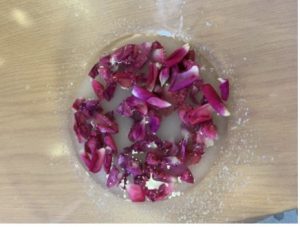
Rose petals in sugar and rose water. Photo credit: Anna Fielding.
Roses were important for early modern households, serving several purposes, culinary and medicinal. Where sleep was concerned, they were useful as they soothed headaches, helped cool the body and concentrated heat on the stomach. Roses were also used as a mood enhancer (‘to ward off melancholy’). Today they are a known soporific which can bring on sleep through their relaxing and stress-relieving properties, as well as having digestive and pain-relieving qualities. As the rose harvest came to an end in September, Anna and the Ordsall visitors processed the petals in several different ways, using early modern recipe books to guide them. The first was to crystallise them with rosewater and sugar.
Hannah Woolley, in The Queen-Like Closet (1670), advised to preserve rose petals by dipping in egg white and then sugar. As some of the group were vegan we attempted this without the egg whites. In William Rabisha’s The Whole Body of Cookery Dissected (1661), he gives instructions ‘to candy rose-leaves [which we assumed to be the petals] as natural as if they grew on trees’: ‘…sprinkle them with rose-water’ and ‘searce [grind] sugar thinly all over them.’ Dipping the rose petals in rosewater, we noticed that they were ‘aquaphobic’ as they repelled the water. This made coating them in sugar difficult. Clearly, the egg white was the glue we needed to crystallise them properly. We wondered if, as a vegan alternative we could use aquafaba (the water from a tin of chickpeas). Anna subsequently tried this and the results are below. It is worth noting here that we had assumed Rabisha was writing about rose petals but remaking this recipe showed that he could well have been referring to the leaves themselves. Rose leaves are edible but rather bitter. They can be used in teas.
The second way we processed rose petals was through grinding and boiling them with sugar and rosewater then shaping the resulting sugar candy to make sweets, as instructed by Robert May in his book The Accomplisht Cook (1670):
To make a paste of violets, cowslips, burrage (borage), bugloss, rosemary flowers &c.
Take any of these flowers, pick the best of them, and stamp them in a stone mortar, then take double refined sugar (white sugar), and boil it to a candy height with a much rosewater as will melt it, stir it continually in the boiling, and being boiled thick, cast it into lumps on a pye plate, when it is cold, box them, and keep them all the year in a stove.
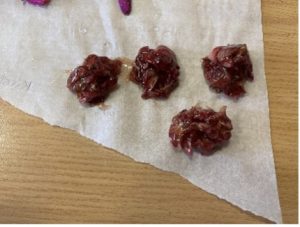
Candied rose flowers. Photo credit: Anna Fielding.
We poured our candy mixture onto greaseproof paper to allow the sweets to set, several people using the paper once the sweets had hardened to wrap the candies like a traditional sweet wrapper. The mixture cooled quickly, allowing the sweets to also be shaped into balls. These were delicious and very popular.
One thing we explored was the term ‘candy height’, which appeared in many preserving recipes. Sugar behaves in very different ways depending on how long it is boiled for, what is added, and how it is handled. How did early modern people know when their sugar was ready without thermometers? Using the senses and observational skills was important. A common way today is to see how the sugar mix reacts in water. For a soft candy, the sugar should form a ball pliable when dropped in cold water. For a hard candy (like rock) the sugar should form strands in cold water. Early modern instructions used similar techniques. Hannah Woolley described how the sugar will be ready for a hard candy when ‘a drop will run as small as a hair’ (The Queen-Like Closet). In A Queen’s Delight, by A.W. from 1671, the instructions state candy height was ‘when you may draw it in small threads between your finger and your thumb.’
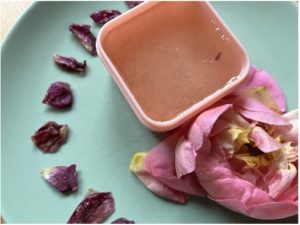
Preserved rose petals. Photo credit: Anna Fielding.
Several recipes from Hannah Woolley, Gervase Markham (The English Housewife, 1615) and Robert May (The Accomplisht Cook, 1670) described how to candy petals by boiling them up with sugar and rosewater. Given the problems we had with the crystallised petals without egg white, Anna boiled up our problem petals briefly in sugar and rosewater when she got home, fishing them out of the mixture after a few minutes, and leaving them to dry on some greaseproof paper. The result were some lovely hard preserved petals. However, they didn’t keep their shape like crystallised ones do.
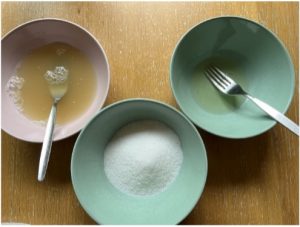
Bowls of aquafaba, egg white and sugar. Photo credit: Anna Fielding.
Returning to the crystallising technique, Anna dipped some fresh rose petals from the garden into egg white and then coated in sugar. She also added borage flowers from Ordsall’s gardens. At the same time, she tried another batch of petals with aquafaba and sugar to create a vegan version. Both of these methods resulted in some beautiful hard petals which should keep for several weeks. However, the process was messy and the liquid combined with the sugar to form clumps before eventually dissolving into syrupy sludge. A better technique would be to coat in the egg white/aquafaba and then sprinkle both sides in sugar. Online recipes advise to use a couple of small clean paint brushes to apply the wet and dry ingredients. Doing this meant the petals kept their shape beautifully.
This first flower preserving workshop informed a second one, at Chetham’s Library in Manchester, as part of their Medieval Festival at the end of September. Anna and Jo Green, head gardener at Ordsall Hall, worked with festivalgoers to preserve rose and borage flowers, using sugar, rosewater, egg, aquafaba and also gum Arabic.
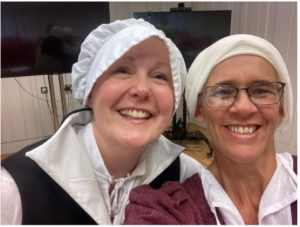
Anna Fielding and Jo Green in Tudor costume at Manchester Medieval Festival. Photo credit: Jo Green.
Gum Arabic and gum tragacanth were used, alongside sugar, to preserve ingredients and they are still found in our foods today for this reason. Several recipes for preserving flower petals featured these aromatic tree resins, indicating these were an available option if one could afford them. The Chethams workshop was a good opportunity to test this additional technique. Referring back to William Rabisha’s The Whole Body of Cookery Dissected (1661), he instructed the reader to ‘candy all manner of flowers in their natural colours’ using ‘a little rosewater, wherein gum arabick is dissolved’ to wash the petals. One then had to ‘take fine searced sugar, and dust over them…’ This provided another alternative to egg whites that worked well. The gum Arabic took several hours to dissolve in rosewater, which was only determined through trial and error, though clues were gained through some rare but informative instructions from Gervase Markham in 1615 and Hannah Woolley in 1670 that gum dragon (what we called gum tragacanth) needed to be soaked in rosewater for two days! This is further evidence for the Anna and the Ordsall visitors showing that early modern recipes need to be made in order to understand them sufficiently.
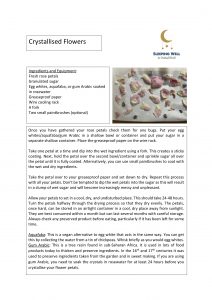
There was a medicinal quality to sugar and lots of overlap between culinary sweets and preserved medicinal ingredients. Several cookbook authors wrote about the health benefits of sugary conserves. In A.W.’s A Queens Delight (1671), after recipes for various conserves, the author listed their ‘vertues.’ A conserve of violets cooled the body, calmed the stomach, and helped with sleep. For conserve of roses, the author noted that ‘the stomach…it cooleth and hindereth vapours.’ These benefits settled the stomach, aided digestion, and brought about better sleep as a result.
This is obviously in opposition to our thoughts on sugar today and it goes without saying that you should avoid too much sugar, particularly in the run up to bedtime. What this sugary workshop has done for us is show how important and labour-intensive food preservation was for families like the Radclyffes of Ordsall. This was not just a way to stock up ingredients as the nights closed in or show off one’s culinary skills, but also a time when people would plan ahead to ensure that they slept well throughout the year. The workshop was an opportunity for participants to try some experiments with early modern recipes and garden produce, pick up some preserving hints, and explore how important sleep was for early modern people in their everyday lives. The workshop participants enjoyed trying these recipes and discovering problems, learning along the way how using historical recipes can reveal when the authors assumed a certain amount of knowledge, leaving out what we considered to be important steps.








0 Comments